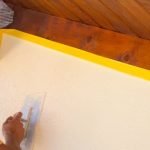Looking to learn how to write off home improvements on taxes? It’s essential to understand the key differences between home improvement expenses and repairs, and how each can impact your taxes. From energy-efficient upgrades to home office renovations, there are various types of home improvements that are eligible for tax write-offs. In this article, we’ll explore the eligibility criteria, the importance of detailed records, and how to calculate your tax deductions for home improvements.
When it comes to eligible home improvement expenses, there are several categories that you may qualify for write-offs. These include energy-efficient upgrades, medical accommodations, and home office renovations. It’s crucial to keep detailed records of all your home improvement expenses, from receipts and invoices to contracts. This will not only help you accurately calculate your tax deductions but also ensure that you have the necessary documentation in case of an IRS audit.
In addition to understanding the specific guidelines for deducting the cost of home office renovations, we’ll delve into the various federal and state tax credits available for energy-efficient upgrades. From solar panels to insulation and energy-efficient appliances, there are opportunities to maximize your tax benefits through these credits.
And finally, we’ll discuss the value of seeking professional tax advice when it comes to writing off home improvements on taxes and common mistakes to avoid along the way.
Eligible Home Improvement Expenses
When it comes to writing off home improvements on taxes, there are several types of home improvements that are eligible for tax write-offs. One common category is energy-efficient upgrades. This can include installing solar panels, upgrading to energy-efficient appliances, or making changes to increase a home’s energy efficiency. These types of improvements not only benefit the environment, but they can also result in valuable tax credits for homeowners.
Another type of home improvement that is eligible for tax write-offs includes medical accommodations. This can include modifications made to a home to accommodate a disabled or elderly individual. These modifications may include adding accessibility features such as ramps or widened doorways, as well as installing medical equipment within the home.
Additionally, home office renovations are also eligible for tax deductions. If you use a portion of your home regularly and exclusively for business purposes, you may be able to deduct expenses related to the renovation or maintenance of that space. This can include costs associated with painting the room, replacing flooring, or making other necessary changes to create a functional work environment.
| Eligible Home Improvement Expenses | Description |
|---|---|
| Energy-Efficient Upgrades | Installing solar panels, upgrading to energy-efficient appliances |
| Medical Accommodations | Adding accessibility features such as ramps and widened doorways |
| Home Office Renovations | Deducting expenses related to creating a functional work environment within the home |
Keeping Detailed Records
When it comes to writing off home improvements on taxes, one of the most crucial aspects is maintaining detailed records of all expenses. Without thorough documentation, you may not be able to substantiate your claims for tax deductions in the event of an audit. Therefore, it is essential to keep meticulous records of all home improvement expenses, including receipts, invoices, and contracts.
Importance of Detailed Records
Keeping detailed records of home improvement expenses is essential for demonstrating the validity of your tax deductions. This documentation serves as evidence that the expenses were incurred and that they meet the criteria for eligible tax write-offs. In the absence of proper records, the IRS may disallow your deductions, leading to potential penalties and interest charges.
Organizing Your Documentation
To effectively capture and maintain documentation for home improvement expenses, it is important to implement a systematic approach. Consider creating digital copies of receipts and invoices and organizing them into categorized folders for easy retrieval. Additionally, maintaining a spreadsheet that details each expense can help ensure that no documentation is overlooked when it comes time to claim deductions on your taxes.
Tips for Record-Keeping
In addition to saving physical and digital copies of receipts and invoices, consider documenting the purpose of each expense and how it relates to a qualifying home improvement category. It’s also advisable to retain contracts or agreements with contractors or vendors detailing the scope of work performed and associated costs. By following these tips and maintaining organized documentation, you can confidently substantiate your home improvement tax deductions when filing your taxes.
By understanding the importance of keeping detailed records for home improvement expenses and following best practices for documentation, you can maximize your tax benefits while minimizing the risk of facing IRS scrutiny over unsubstantiated deductions.
Calculating Your Home Improvement Tax Deductions
When it comes to writing off home improvements on taxes, accurately calculating your tax deductions is crucial. It’s important to understand the specific guidelines and requirements set forth by the Internal Revenue Service (IRS) to ensure that you are maximizing your tax benefits while staying compliant with tax laws.
Understanding IRS Form 5695 for Energy-Efficient Upgrades
One key aspect of calculating your home improvement tax deductions is utilizing IRS Form 5695 for energy-efficient upgrades. This form allows homeowners to claim a residential energy credit for expenses related to qualifying energy-efficient improvements made to their homes. These improvements can include solar panels, wind turbines, geothermal heat pumps, and other eligible technologies.
Thorough Documentation and Record-Keeping
In order to accurately calculate your tax deductions for home improvements, you must maintain detailed records of all relevant expenses. This includes keeping track of receipts, invoices, contracts, and other documentation that supports the costs associated with the improvements. Without thorough record-keeping, it may be challenging to substantiate your deductions in the event of an IRS audit or inquiry.
Given the complexity of tax laws and regulations related to home improvement expenses, it is highly advisable to seek professional guidance from a qualified tax advisor or accountant. A professional can provide valuable insights into how to accurately calculate your tax deductions for home improvements and can help ensure that you are taking advantage of all eligible credits and deductions.
By understanding the intricacies of calculating home improvement tax deductions and staying informed about IRS requirements, homeowners can position themselves to maximize their tax savings while maintaining compliance with applicable laws.
Deducting the Cost of Home Office Renovations
When it comes to deducting the cost of home office renovations on your taxes, there are specific guidelines that you need to understand in order to maximize your tax benefits. The first step is to determine if the renovations qualify as a deductible expense.
In general, home office expenses are deductible if the space is used exclusively and regularly for business purposes. This means that any renovations or improvements made to this area of your home may be eligible for a tax write-off.
To determine the amount that can be deducted, you will need to calculate the percentage of your home that is used for business. This will involve measuring the square footage of your home office in relation to the total square footage of your entire home. The resulting percentage is what you can use to allocate a portion of your home improvement expenses as a deduction on your taxes.
It’s important to keep detailed records of all expenses related to the home office renovations, including receipts, invoices, and contracts. This documentation will be essential in case of an audit by the IRS and will help support your claim for deductions. Additionally, be sure to utilize IRS Form 8829 when calculating and reporting these expenses on your tax return.
Meeting With a Professional Tax Advisor
Your professional tax advisor can provide valuable guidance on how to properly deduct the cost of home office renovations on your taxes and maximize your tax benefits. They can assist in determining if certain expenditures qualify for deductions, advise on best practices for documentation, and help navigate any potential audits or inquiries from taxing authorities.
| Renovation Expense | Cost |
|---|---|
| New furniture | $1,500 |
| Paint & Decor | $800 |
Tax Credits for Energy-Efficient Home Improvements
One of the most beneficial ways to write off home improvements on taxes is by taking advantage of tax credits for energy-efficient upgrades. These credits are available at both the federal and state levels and can provide significant savings for homeowners looking to reduce their tax liability while improving their homes.
Federal tax credits for energy-efficient home improvements include incentives for solar panels, insulation, energy-efficient windows, doors, and skylights, as well as geothermal heat pumps and small wind turbines. Each type of improvement has specific requirements that must be met to qualify for the credit, such as minimum energy efficiency standards or certification from approved agencies.
In addition to federal tax credits, many states also offer their own incentives for energy-efficient home improvements. These can include additional credits or rebates for the installation of renewable energy systems, such as solar panels or wind turbines, as well as programs specifically tailored to promote energy efficiency within residential properties.
By taking advantage of these tax credits, homeowners can not only save money on their taxes but also contribute to a more sustainable and environmentally friendly living space. Before making any improvements, it’s important to research the available credits and consult with a professional tax advisor to ensure eligibility and maximize potential savings.
Hiring a Professional Tax Advisor
When it comes to understanding how to write off home improvements on taxes, seeking professional tax advice can be invaluable. A tax advisor can provide guidance on potential tax implications and help you maximize your deductions, ensuring that you take full advantage of all available tax benefits. Here are some key reasons why hiring a professional tax advisor is beneficial when it comes to writing off home improvements:
- Expertise: A professional tax advisor has in-depth knowledge of complex tax laws and regulations, especially those related to home improvement deductions. They can provide personalized advice tailored to your specific situation, helping you make informed decisions about which expenses are eligible for write-offs.
- Maximizing Deductions: With a tax advisor’s assistance, you can ensure that you are maximizing your deductions for home improvements. They can help you identify all eligible expenses and credits, ultimately reducing your overall tax liability.
- Avoiding Audits and Penalties: By working with a professional, you can minimize the risk of errors or inaccuracies in your tax filings related to home improvements. This reduces the likelihood of being audited by the IRS or facing penalties for improper claims.
In addition to providing expert guidance on writing off home improvements on taxes, a professional tax advisor can also offer valuable support in other areas of personal finance. From retirement planning to investment strategies, they can help you navigate the complexities of the tax code and make informed decisions that align with your financial goals.
Ultimately, collaborating with a seasoned tax professional ensures that you are well-equipped to navigate the intricacies of claiming home improvement deductions on your taxes. Their expertise and personalized guidance can make a significant impact on maximizing your overall tax savings while also avoiding potential pitfalls associated with improper claims.
Avoiding Common Mistakes
When it comes to writing off home improvements on taxes, it is important to be aware of common mistakes that can potentially cost you valuable deductions. By avoiding these errors, you can maximize your tax savings and ensure that you are taking full advantage of all eligible credits and deductions.
Here are some common mistakes to avoid when writing off home improvements on taxes:
- Inaccurately Categorizing Expenses: One common mistake is inaccurately categorizing expenses as home improvement costs when they are actually repairs. It is crucial to understand the difference between the two, as only home improvement expenses are eligible for tax write-offs.
- Failing to Claim Eligible Credits: Another mistake to avoid is failing to claim eligible credits for energy-efficient home improvements. This includes overlooking federal and state tax credits for upgrades such as solar panels, insulation, and energy-efficient appliances.
By staying informed and diligent in your record-keeping and tax preparation, you can ensure that you are not making costly mistakes when it comes to writing off home improvements on taxes.
It is also important to seek professional tax advice to avoid potential pitfalls and make the most of available deductions. A professional tax advisor can guide you through the process of identifying eligible expenses, claiming credits, and avoiding common errors that could impact your tax savings. With their expertise, you can feel confident in navigating the complexities of tax laws related to home improvements.
Conclusion
In conclusion, understanding the intricacies of tax deductions for home improvements can help homeowners maximize their savings. By distinguishing between home improvement expenses and repairs, keeping detailed records, and calculating deductions accurately using IRS Form 5695, individuals can ensure they are taking full advantage of eligible write-offs. It is essential to remember that certain home office renovations and energy-efficient upgrades may also qualify for tax deductions, providing additional opportunities for savings.
Moreover, exploring available tax credits for energy-efficient home improvements, such as solar panels and energy-efficient appliances, can further enhance potential tax benefits. However, it is crucial to seek professional tax advice to navigate the complexities of writing off home improvements on taxes effectively. Consulting a tax advisor can help individuals avoid common mistakes and identify all eligible credits, ultimately maximizing their deductions.
As the tax landscape continues to evolve, staying informed about changes in tax laws and regulations is paramount in optimizing tax savings. By remaining proactive in seeking out new opportunities and staying up-to-date with current guidelines, homeowners can position themselves to take full advantage of potential tax benefits for their home improvements. In summary, being well-informed and proactive is key to successfully navigating the process of writing off home improvements on taxes.
Frequently Asked Questions
Can Home Improvements Be a Tax Write Off?
Home improvements can potentially be a tax write off, but it depends on the nature of the improvement. Typically, home improvements to increase energy efficiency or for medical purposes may qualify for tax deductions.
How Do I Prove Home Improvements Without Receipts?
Proving home improvements without receipts can be challenging, but it’s not impossible. Other forms of evidence, such as credit card statements, bank records, contractor agreements, and before-and-after photos, can help substantiate the expenses.
Is Painting a House Tax Deductible?
In most cases, painting a house is considered a regular maintenance expense rather than a tax-deductible home improvement. However, if the painting is part of a larger home improvement project that meets certain criteria, it may be eligible for a tax deduction.

I’m thrilled to have you here as a part of the Remodeling Top community. This is where my journey as an architect and remodeling enthusiast intersects with your passion for transforming houses into dream homes.





